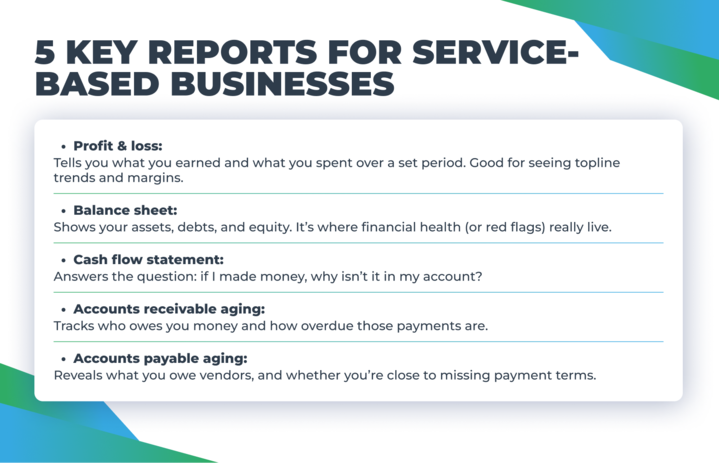Most service-based business owners don’t wake up excited to dive into their bookkeeping. It’s rarely the fun part of running a business. But neglect it for too long, and it quickly becomes the painful part: surprise tax bills, unexplainable cash flow gaps, and growth plans that never quite take off.
The cost of this oversight is more than just stress. Business owners with limited financial literacy lose an average of $118,121 in profit, and 42% admit they had little to no financial knowledge when they started out.
We’ve seen it all: the chaos, the confusion, and the moments when the numbers suddenly click. That’s why, in our latest webinar, Mastering Bookkeeping: Advanced Tactics for Service-Based Businesses, we didn’t sugarcoat things. Rather, we provided the actual roadmap for leveraging your books to create a business that grows, pays you, and makes sense.
Meet the guest speaker

Aileen Martinez is the Founder and CEO of Rise Up Bookkeeping® , where she helps service-based entrepreneurs take control of their finances and build sustainable, profitable businesses. With more than 8 years of experience, she’s dedicated to turning financial chaos into clarity and giving business owners their time (and sanity) back.
Let’s get into the highlights: insightful, practical, and backed by Aileen’s in-the-trenches perspective. This isn’t typical bookkeeping advice. These seven insights reframe how service-based business owners should approach their numbers—not as a chore, but as a strategic advantage.
1. Bookkeeping isn’t data entry—it’s your business strategy in numbers
If you believe bookkeeping is merely uploading receipts and ticking off reconciliations, you’re not getting value from it. It’s not a matter of getting numbers in, but of knowing what the numbers are telling you.
Aileen started out assuming she’d be crunching numbers in the back office. Instead, she found herself helping business owners secure funding, pitch to investors, and turn around struggling operations. Why? Because clean books aren‘t just about compliance, they’re decision-making tools.
“Seeing that green check mark and $0 reconciliation balance… I knew I wasn’t just doing data entry. I was giving them the power to go and get those funds,” says Aileen.
Good books inform you of what’s generating profit, what’s losing you money, and what you should double down on. If your financials aren’t doing that, they’re not only underutilized, they’re failing you.
2. Service-based businesses have unique weak spots—and most owners miss them
As opposed to product companies, service businesses often overlook underlying financial structure. They often act more like freelancers than entrepreneurs: mingling personal and business finances, skipping proper accounting systems, and relying on a shoebox of receipts at tax time.
The problem is that financial fog doesn’t just lead to confusion, it creates risk.
Uncontrolled subscriptions quietly drain your budget. Personal expenses creep onto business cards. Minor leaks like a few forgotten $9.99 trials can balloon into massive overspending. And when there’s no visibility, you can’t fix what you can’t see.
But the real danger goes beyond budget waste. When the line between personal and business finances gets blurry, you lose the legal protections that come with incorporation. Aileen explains it like that:
“You broke that corporate veil. You no longer have that differentiation between your personal and your business finances.”
That’s not a technicality, that’s what will get you into trouble during an audit or a lawsuit.
Clean separation, ongoing tracking, and routine audits of recurring expenses aren’t only best practices, but your safety net.
Learn more about SaaS accounting.
3. You’re not reconciling enough—and it’s costing you
Ask most business owners if they reconcile their books, and they’ll say “yes” without hesitation. But ask if they reconcile clearing accounts, Stripe payouts, processing fees, or payroll liabilities, and the answers get a lot fuzzier.
Reconciliation isn’t just matching your bank statement to your bookkeeping software. That’s the bare minimum. If you’re only looking at your checking account, you’re ignoring major parts of your financial picture, like what’s flowing through your payment processors, what fees are being skimmed off the top, and what tax liabilities are stacking up without notice.
Aileen explains that ignoring these accounts is one of the most common issues she sees, especially with service-based businesses that sell online and manage multiple income streams:
“You have to make sure that everything you’re entering actually matches what’s in the bank… and it’s not just what’s happening in the bank.”
For example, Stripe deposits often hit your account after processing fees are taken out. If you’re not accounting for those fees and reconciling against the gross sales, your income figures are understated, and your books are lying to you. The same applies to payroll taxes: if they aren’t reconciled, unpaid liabilities can quietly pile up and lead to penalties you didn’t budget for.
And it’s not just about accuracy. It’s about credibility. Your balance sheet is where lenders, investors, and CFOs look to assess the financial health of your business, not just your revenue.
As Aileen puts it:
“You might be profitable on paper… but if you’re only sustainable because of constant debt, lenders and investors will notice that.”
Without full reconciliation, your reports don’t reflect reality. And when it comes to taxes, funding, or long-term planning, that disconnect can cost you far more than just bookkeeping errors.
4. The five reports that keep your business sane
Most business owners feel pretty good about their profit & loss statement. It’s the go-to report: simple, familiar, and often the only one they glance at each month. But the moment your P&L says you’re profitable and your bank balance doesn’t agree? That’s when panic sets in, and when it becomes clear the P&L is only part of the story.
Aileen Martinez has worked with enough service-based businesses to know this scenario too well. That’s why she doesn’t let her clients stop at one report. She recommends a full five-report system to keep business owners grounded in the reality of their numbers:

| Note: It’s recommended to review the P&L, balance sheet, and cash flow report monthly, while aging reports should be checked weekly. That frequent check-in is critical for maintaining cash flow and trust. |
“There should never, never, never be anything in that over ninety days column,” Aileen remarks.
Late receivables slow down your growth. Late payables hurt your credibility. And both can spiral into deeper financial stress if left unchecked.
Each report serves a purpose. Together, they give you clarity, not just on where your business has been, but what’s coming if you don’t course correct. As Aileen sees it, they’re not optional, they’re how you keep your business sane.
5. Turning around a business on the brink
Some financial stories don’t start with ambition, they start with survival. One of Aileen Martinez’s most striking client transformations began when a business owner came to her completely overwhelmed. She hadn’t built the company, she’d inherited it from her parents. Along with the ownership came crumbling systems and more than $100,000 in debt.
There were no real books to speak of, just chaos. Contractors overspending without oversight. Business credit cards swiped left and right. Subscriptions nobody remembered signing up for. And a growing fear that the whole thing would collapse.
But instead of patching holes, Aileen helped her rebuild from the foundation.
- First, they cleaned up the books for the entire previous year, getting a true read on how bad the losses were.
- Then came the uncomfortable but necessary part: auditing expenses line by line, reining in supply costs, monitoring team spending, and tracking every dollar of income by service.
They didn’t chase growth right away. They chased clarity.
“We were able to realize she was losing a hundred grand in that year of business, and we were able to catch why,” Aileen explains.
What followed wasn’t a dramatic overnight success. It was consistency: monthly review meetings, revenue forecasting based on seasonal trends, and smarter planning for peak sales periods. Bit by bit, the waste was cut, income rose, and financial decisions stopped being emotional.
After a year of working together, the business had gone from six-figure losses to breaking even.
“It might not seem like a lot, but for someone who was losing $100 grand a year, it makes that difference.”
It wasn’t flashy. But it was sustainable. And that’s what kept the doors open and positioned the business for real growth.
6. Marketing without data is just gambling
It’s easy to fall into the trap: boost an Instagram post, hire a freelance SEO wizard, drop a few thousand on Google Ads, and hope for the best. But hope isn’t a strategy. And in Aileen Martinez’s experience, this is one of the fastest ways service-based businesses burn through cash without anything to show for it.
“Without the financial data backing you… your marketing dollars are just going out into the void and you’re hoping for the best,” Aileen says.
Data transforms guesswork into strategy. Your bookkeeping, done right, tells you more than just how much you made. It shows you how you made it.
- Which offer brought in the most income?
- Which clients were actually profitable after processing fees?
- Where did ad spend pay off, and where did it quietly eat your margins?
Many businesses get caught up in vanity numbers. A $60K launch sounds great until you account for $15K in ad spend, $4K in refunds, and 3% in transaction fees. If you’re not tracking these details in your books, your “big win” might actually be a financial step backward.
She encourages clients to break income down by vertical: “Let’s say you’re a coaching business,” she says. “You should be able to break down your income verticals between, ‘this is how much I make one-on-one, this is how much I make in group coaching, and this is how much I make on my speaking gigs.”
That level of clarity lets you double down on what’s working and cut what’s not before it drains your momentum. Marketing becomes intentional, not emotional. You’re no longer making decisions based on gut feel, but grounded insight.
So if you’re putting money behind offers you think work, but don’t actually know the numbers behind them—pause. Revisit your books. Because scaling without data isn’t scaling. It’s just staying busy.
7. Automation isn’t just for ecommerce, but for anyone who sells online
Did you know that close to 75% of accounting tasks can be automated with the right software solutions? Some businesses might assume automation tools like Synder are only for product sellers: product names, SKUs, and inventory tracking. But in today’s world, if you’re selling anything online—a digital course, a coaching package, a creative service—you’re operating in the ecommerce space. And if you’re still doing it manually, you’re wasting more than time.
Aileen Martinez calls it the “manual madness.”
“I remember a time before I even knew Synder existed—manually entering every invoice, every sales receipt, every payment that came in.”
Aileen Martinez , the Founder and CEO of Rise Up Bookkeeping®
At first, it feels manageable. A handful of invoices here. A few Stripe payouts there. But once your volume increases, that manual entry starts to snowball along with the errors. Payouts don’t match deposits. Fees disappear from view. Refunds get buried. And you spend more time fixing your books than actually running your business.
“Even just 10 invoices you have to enter manually—that takes up so much of your time that could be used for something else,” Aileen says.
How Synder changes the game
For service-based businesses selling online, Synder acts as an automation powerhouse. It syncs all sales, fees, taxes, refunds, and payouts from platforms like Stripe, PayPal, Square, and more, then pushes them cleanly into QuickBooks, Xero, Sage Intacct and soon NetSuite. No more duplications, missed fees, or guessing.
Synder handles:
- Detailed transaction syncs with full breakdowns of gross sales, fees, refunds, and taxes
- Multi-platform support across Stripe, PayPal, Shopify, Square, Amazon, Etsy, and more
- Automated invoice and sales receipt creation in the most popular accounting software
- Auto-reconciliation of clearing accounts to keep books audit-ready
- Customer-level profitability reports to identify top-performing clients and services
“Synder’s that bridge between where you’re selling and the reporting of that all… If you’re not reflecting the same thing in QuickBooks and you get audited, there’s a disconnect there.”
Aileen Martinez , the Founder and CEO of Rise Up Bookkeeping®
And it’s not just about clean data—it’s about insights you can use. With Synder, you can easily run custom reports to see which offers drive the most revenue, which clients spend the most, and which payment processors are cutting deepest into your profits.
“Because Synder is able to bring in every transaction per customer… you’re able to run reports in QuickBooks that tell you: this client spent the most, this one spent the least. That gives you insight to say—who do I want more of?”
Aileen Martinez , the Founder and CEO of Rise Up Bookkeeping®
In short: Synder isn’t just automation. It’s financial clarity, strategic insight, and scalable infrastructure for service businesses that are tired of duct-tape bookkeeping.
Test it yourself with a 15-day free trial, or join one of our Weekly Public Demos for a guided walk-through with our product experts. Whether you’re running a coaching business, a creative agency, or a SaaS service, Synder gives you the back-office power of a CFO—on autopilot.
Conclusion: Use your numbers, then let Synder do the rest
You don’t need to become a bookkeeper, but you do need to know what your numbers are telling you. The difference between businesses that grow and those that stall is simple: visibility and action. If you’re not going to do the bookkeeping yourself, hire someone to do it. But either way—get in the books.
And once you’re in, automate the rest with Synder. Synder integrates with multiple platforms, syncing every sale, fee, and refund automatically, so your books stay clean, your reports stay accurate, and your time stays yours.
Whatever you do, if you sell online, Synder was built for you.

.png)




